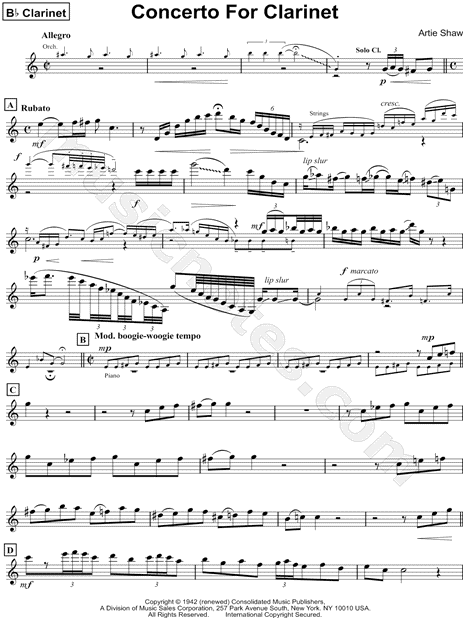Clarinet Concerto Pdf

Author: Clarinet Institute of Los Angeles - www.clarinetinstitute.com Subject: Clarinet Institute of Los Angeles Keywords: Clarinet Institute of Los Angeles - www.clarinetinstitute.com.
Contents • • • • • • • • History [ ] As there is no autograph for this concerto and as it was published posthumously, it is difficult to understand all of Mozart's intentions. [ ] The only relic of this concerto written in Mozart's hand is an excerpt of an earlier rendition of the concerto written for in G (K. [ ] This excerpt is nearly identical to the corresponding section in the published version for A clarinet. [ ] Mozart originally intended the piece to be written for basset horn, as Anton Stadler was also a virtuoso basset horn player, but eventually was convinced the piece would be more effective for clarinet.
Eskw biblioteka kompas. Known for her fusion of traditional Haitian rhythms (kompa, rasyn, and twoubadou) with other musical genres (pop, jazz, and blues), Michel created a sound,.
[ ] However, several notes throughout the piece go beyond the conventional range of the A clarinet; Mozart may have intended the piece to be played on the, a special clarinet championed by Stadler that had a range down to low (written) C, instead of stopping at (written) E as standard clarinets do. Even in Mozart's day, the basset clarinet was a rare, custom-made instrument, so when the piece was published posthumously, a new version was arranged with the low notes to regular range. [ ] This has proven a problematic decision, as the autograph no longer exists, having been by Stadler, and until the mid 20th century did not know that the only version of the concerto written by Mozart's hand had not been heard since Stadler's lifetime. Attempts were made to reconstruct the original version, and new basset clarinets have been built for the specific purpose of performing Mozart's concerto. Music [ ] The modern scoring of the work is for solo, two, two, two (in A and D, often transcribed for horns in F), [ ].
Audio files of Mozart's Clarinet Concerto. It soon transforms into a flurry of sixteenth notes in descending, played by the violins and flutes while the lower instruments drive the piece forward. After the, the strings begin a series of before the first closing theme, featuring dueling violin I's and violin II's, enters. The second closing theme is much more subtle until the of its final two bars. As the soloist enters, the clarinet repeats the opening theme with the expected added ornamentation. As the orchestra restates the main theme, the clarinet traverses the whole range of the instrument with several flourishes. The secondary theme begins in the, and eventually tonicizes C major before arriving in the, E major.
At the end of the E-major section, there is a short pause, where the soloist conventionally improvises a short (cadenza), although no context is offered for a true cadenza. The canonic material of the opening ritornello returns, this time involving the clarinet and leads to the novel feature of the soloist accompanying the orchestra with an over the first closing theme. The orchestral ritornello returns, ending with the second closing theme. The explores a few new key areas including F ♯ minor and D major, and even has some hints of the Baroque. Before the formal orchestral ritornello leading into the, Mozart writes a series of descending sequences with the cellos and bassoons holding over strings.
As is conventional in Classical concerto form, in the recapitulation the soloist and orchestra are united, and the secondary theme is altered to stay in the. As the secondary theme comes to a close, the clarinet has another chance to improvise briefly, and this time leads the canonic material that follows. The Alberti bass and over for the soloist recur before the movement ends in a cheerful final orchestral ritornello. The solo exposition of this movement appears in almost every professional orchestral clarinet audition. Adagio [ ] The second movement, which is in (i.e.
ABA'), is in D major. It opens with the soloist playing the movement's primary theme with orchestral repetition. The B section, in which the solo part is always prominent, exploits both the and registers. The only true of the entire work occurs right at the end of the B section, immediately before the return of the A section. There are some passages that exploit the lowest notes of the basset clarinet in the B section.
Rondo: Allegro [ ] The concerto ends with a movement in A major. This movement is a blend of and that Mozart developed in his piano concertos, most notably the. It is in ABACABA form, with the middle A's being shorter restatements of the theme, unlike regular which is ABACA. The movement opens with a cheerful theme. This refrain is interspersed with episodes either echoing this mood or recalling the darker colours of the first movement: • The first A (bars 1–56) features the soloist in dialogue with the orchestra, often one phrase seamlessly into the next. In some ways the orchestra and soloist are competing with one another —the more definitive the statement made by the orchestra, the more virtuosic the response by the clarinet. • The first B (bars 57–113) begins with a lyrical theme, and eventually features and some very dramatic lines which feature the extended range of the basset clarinet.